With Atlético Madrid claiming a 2-0 victory over Real Sociedad, the pressure was on Real Madrid to respond with a victory and remain level on points with their crosstown rival.
Their opponent was Granada, a side that, like Madrid, seemed to have recovered from a poor five-week stretch of play. December saw them advance in the Europa League and Copa del Rey, as well as claim back-to-back La Liga victories.
In this tactical analysis, we’ll look at Granada’s high press and the early chances it produced. That press presented some early issues for Real Madrid, but it is a problem they managed to solve. This analysis will look at the tactics Zinedine Zidane employed in the buildup, as well as his tactics on the right-hand side of the pitch. In the end, Real Madrid managed to walk away with the 2-0 win largely due to Zinedane’s second-half adjustments. His tactical alterations produced more numbers in the box, paving the way for Casemiro’s game-winner. Before we get there, let’s look at the lineups.
Lineups
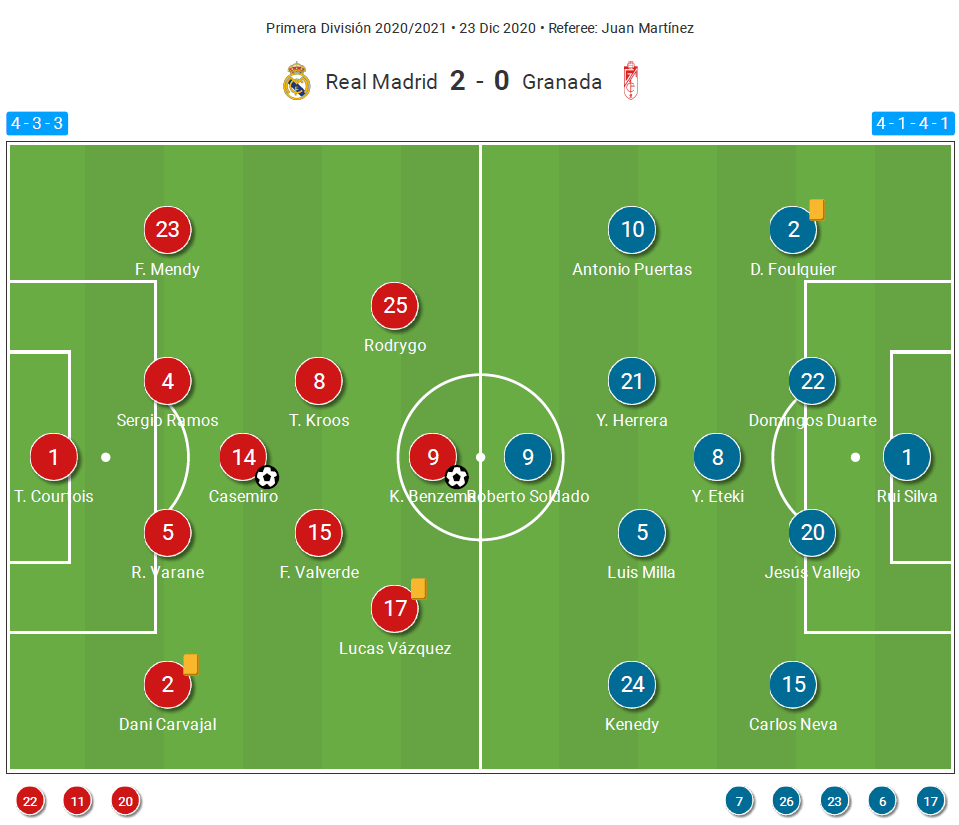
Zidane set Los Blancos out in a 4-3-3 with Thibaut Courtois in the net. Dani Carvajal started on the right with Ferland Mendy opposite him. In the middle of defence were Sergio Ramos and Raphaël Varane. The asymmetric three-man midfield consisted of Casemiro in his deep, central role, Toni Kroos as a left-central regista and Federico Valverde more advanced in the right central part of the pitch.
Rodrygo started the game at left-forward but was forced off with a hamstring injury in the 38th minute. That forced Zidane into a change of tactics against Granada, leading to the introduction of Marco Asensio, who was very lively in this match. He joined Karim Benzema and Lucas Vázquez up top.
For Diego Martínez, the choice in formation was a 4-1-4-1 with the Portuguese, Rui Silva, in goal. From right to left, the backline consisted of Dimitri Foulquier, Domingos Duarte, Real Madrid loanee Jesús Vallejo and Carlos Neva. Yan Eteki manned the pivot while Antonio Puertas, Yangel Herrera, Luis Milla and Kenedy played in front of the Cameroonian. Rounding out the formation was the Real Madrid youth product, Roberto Soldado.
Granada’s high press creates early chances
Last season, Real Madrid and Granada featured two of the best defences in La Liga. You could argue that Real Madrid’s defence was largely responsible for their league title and Granada’s paved the way towards Europa League qualification. Los Blancos recording an xGA of 30.51, while the Nazaríes had the 7th best xGA in the league a with a mark of 42.79.
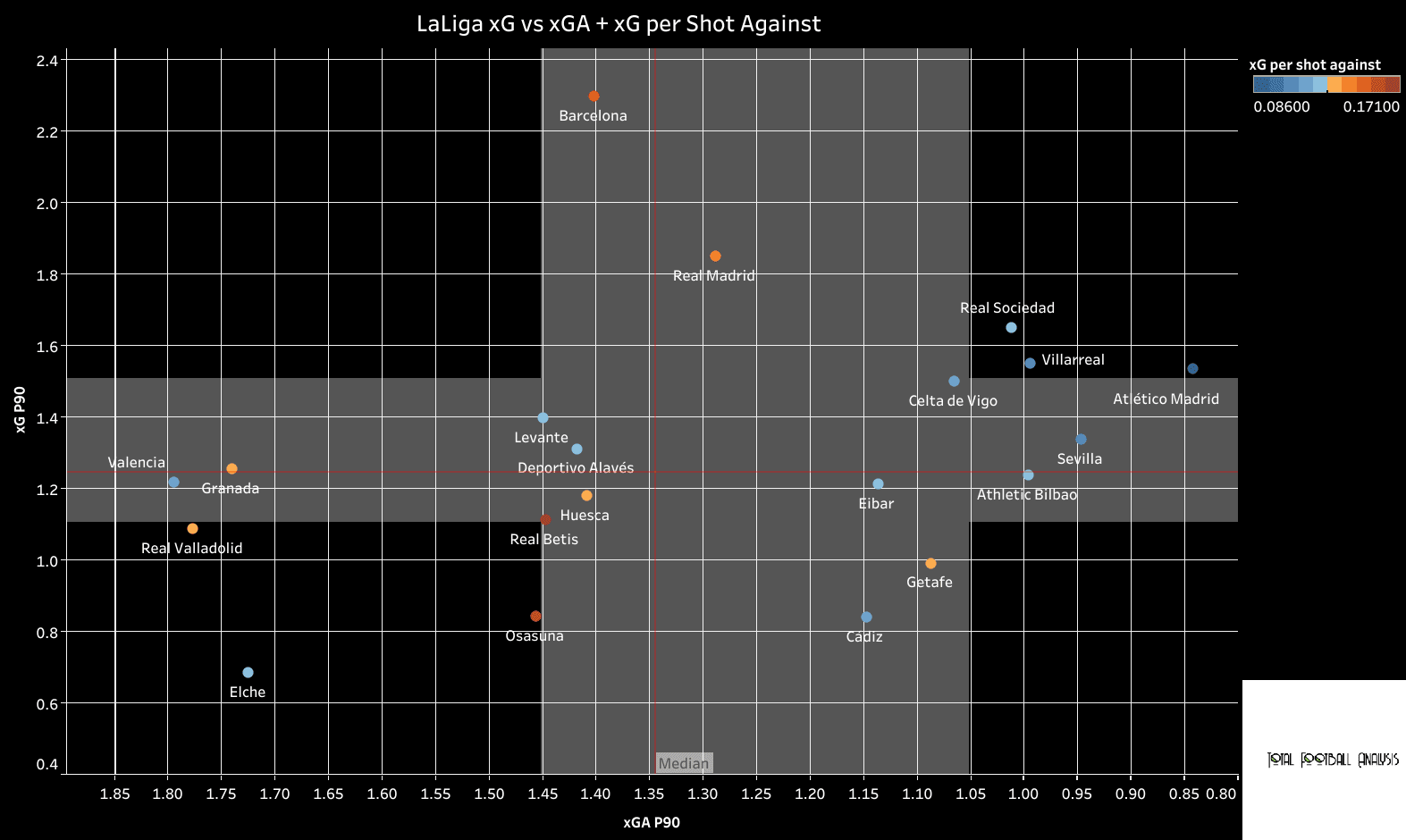
It’s a different story this season with each team struggling to replicate last season’s defensive performances. Madrid rate 10th with a 1.29 xGA while Granada own the third-worst mark at 1.74.
Even with their lacklustre defensive work, Real Madrid have managed to produce the second-best xG in La Liga at 1.85, considerably higher than Granada’s 0.99 xG. Given the away side’s issues, one of the tactical storylines in this match was how Granada would set out to defend. In the early stages of the game, we got our answer as El Graná pressed Madrid high up the pitch. In fact, the high press produced some quality scoring opportunities in the early stages of the game.
Right off the kickoff, Real Madrid attempted to build out of the back. Granada pushed forward to engage them in a high press, funnelling play to the feet of Varane. His attempted pass was blocked, allowing Soldado to recover the ball and dribble into the box.
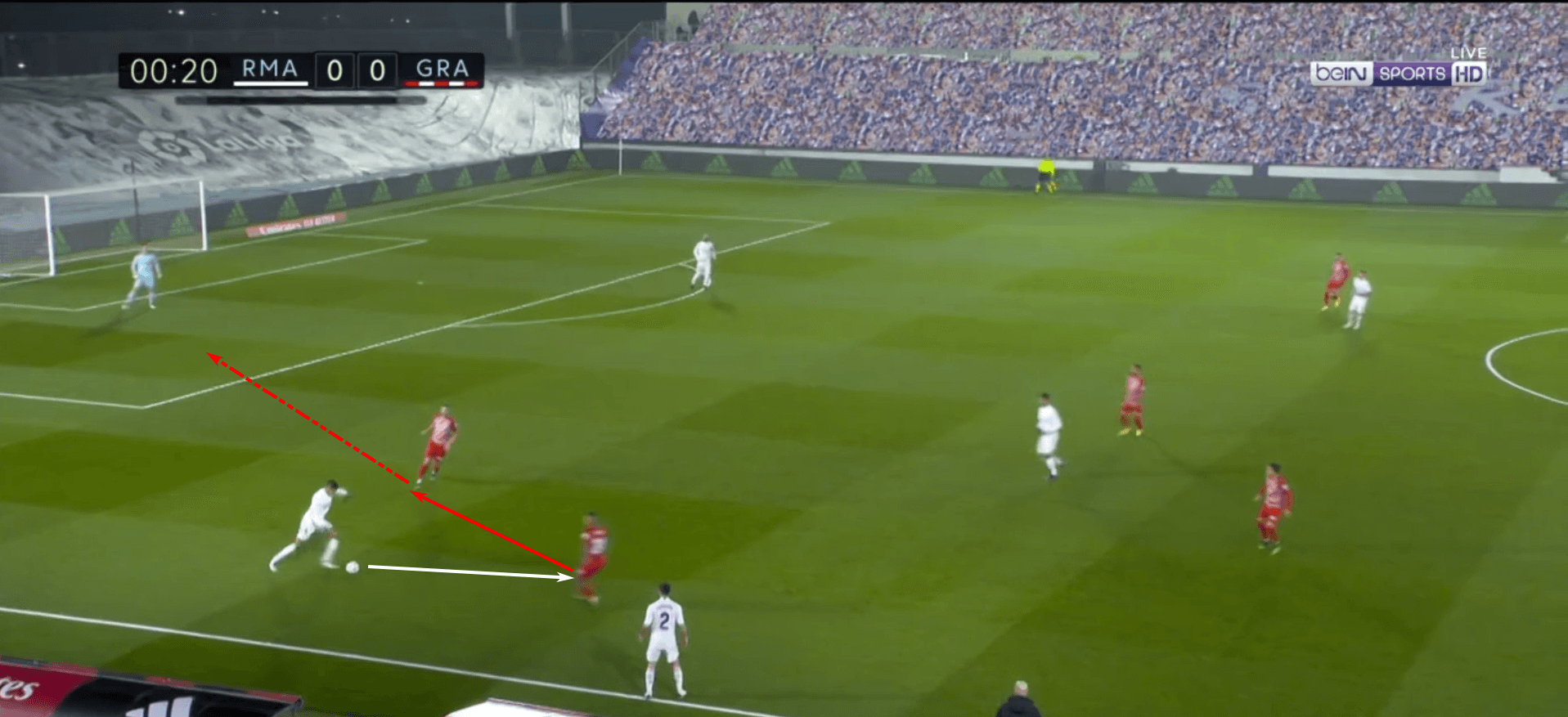
With Real Madrid in a more expensive build-out shape, trusting the deeper players to break the first two pressing lines, the team was stretched defensively and struggled to cope with this particular transitional moment.
As Soldado dribbled into the box, Ramos slid to his right to apply pressure, leaving the middle of the box unoccupied. Casemiro was unable to recover into Ramos’ spot and Mendy was far too high up the pitch to have any role in the play. That left Soldado with an easy square pass into the path of Puertas. The winger skied his attempt, missing a golden opportunity to give Granada the lead just 25 seconds into the match.
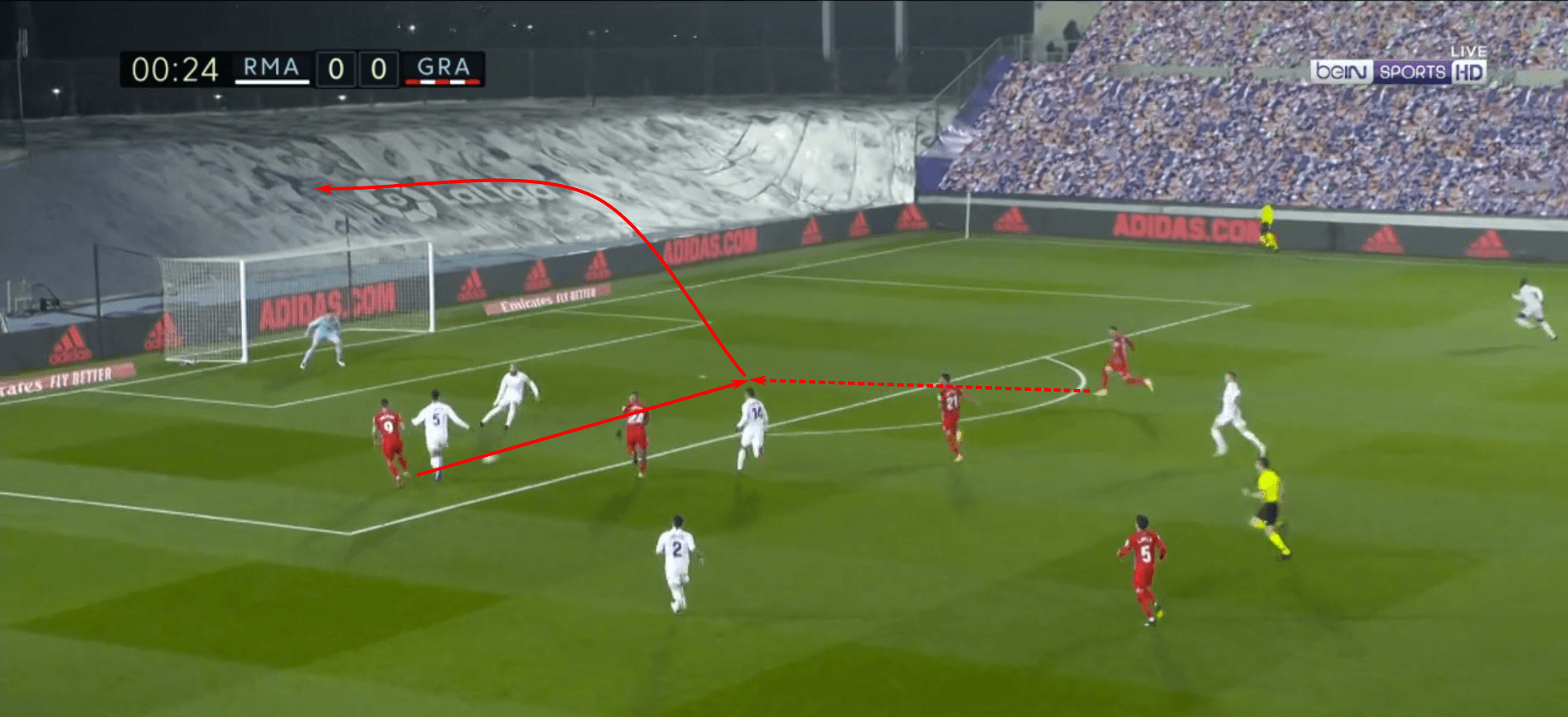
Ever since the first leg of the UEFA Champions League Round of 16 tie against Manchester City, Varane has looked susceptible with the ball at his feet. With the errors becoming more frequent, Granada looked to funnel play to him, then collapse on Real Madrid’s right-hand side. Whether it was down to their confidence in pressing Varane or possibly the combination of Varane and Casemiro, Granada was eager to press high up the pitch.
As they engaged in the high press, Granada looked to funnel play into the wings, using Soldado to pressure the centrebacks while the midfielders picked up Madrid’s outside-backs and centrebacks. That left the visitors man for man in the midfield and plus one at the back.
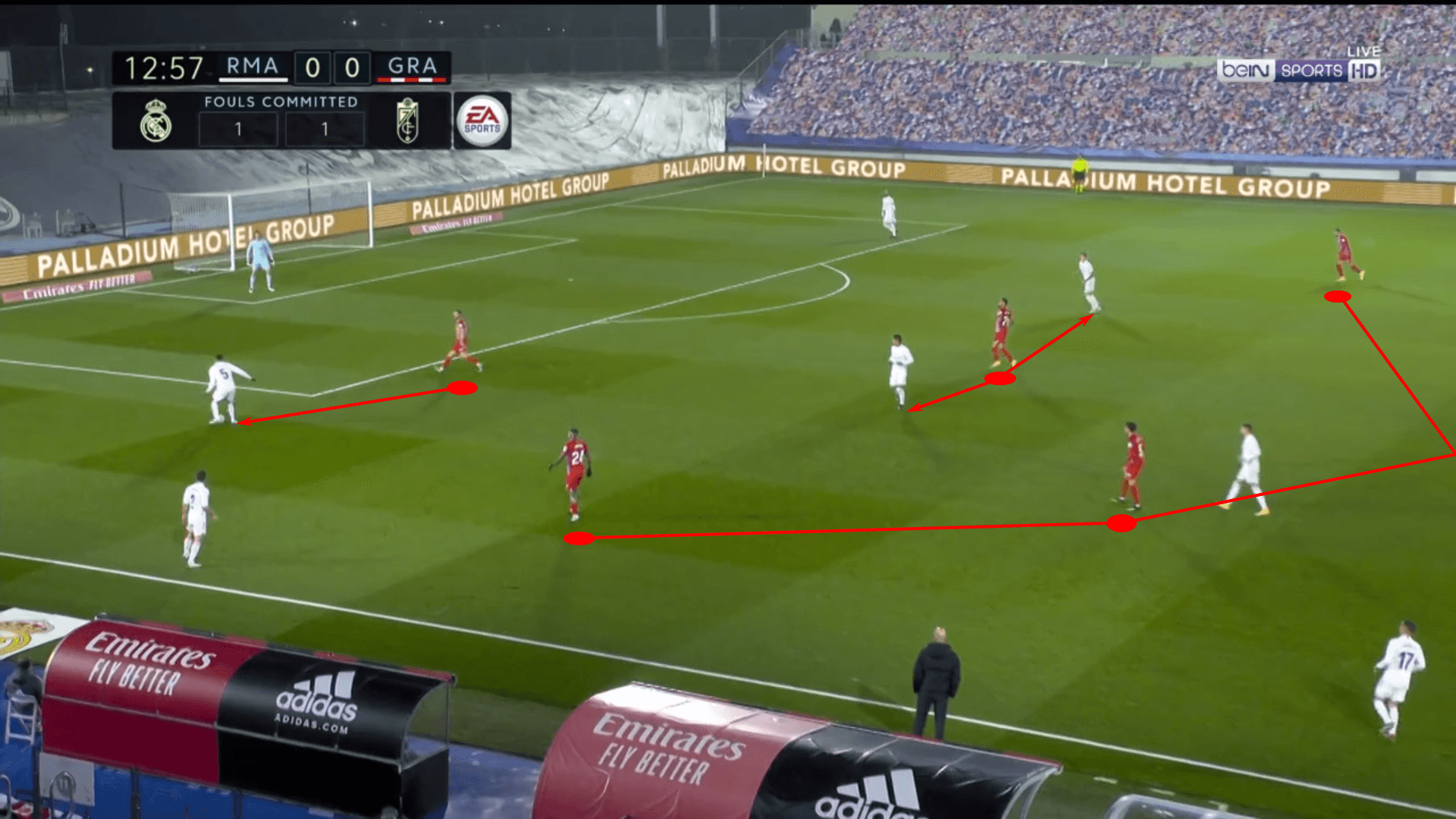
One of the key points in the high press was the occupation of Casemiro and Kroos. In the above image, you can see Herrera moving higher up the pitch to account for the two Madrid midfielders. With him occupying both mids, he freed Eteki to clean up behind the line of four.
As Madrid broke the press through Courtois, the point of attack was switched to Ramos who then carried the ball upfield. With no one to engage Ramos, Granada settled into their 4-5-1 defensive shape rather than pressuring the Spaniard.
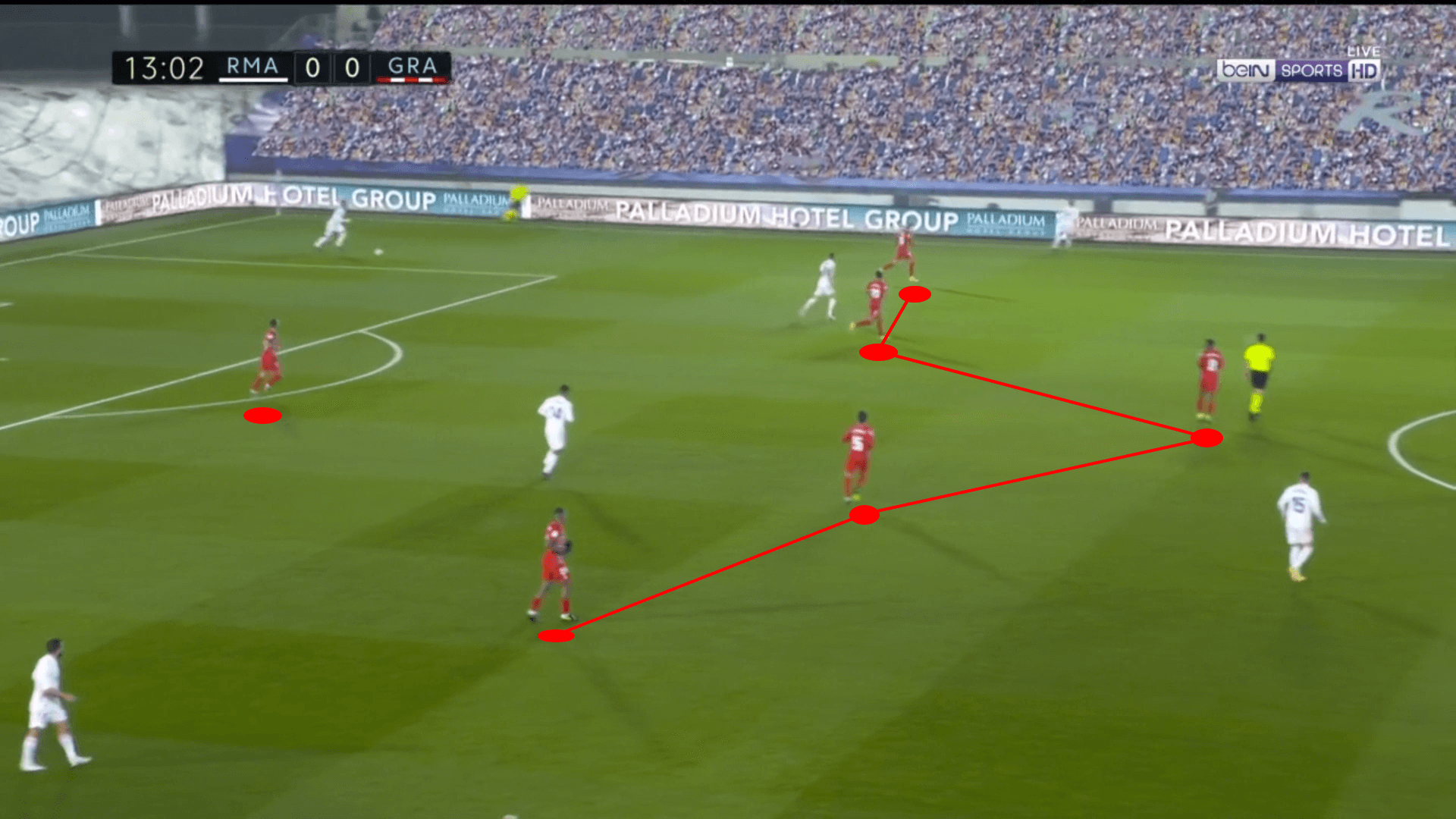
They maintained that shape as Real Madrid entered the middle third of the pitch, funnelling play to the wings and squeezing the width of the pitch.
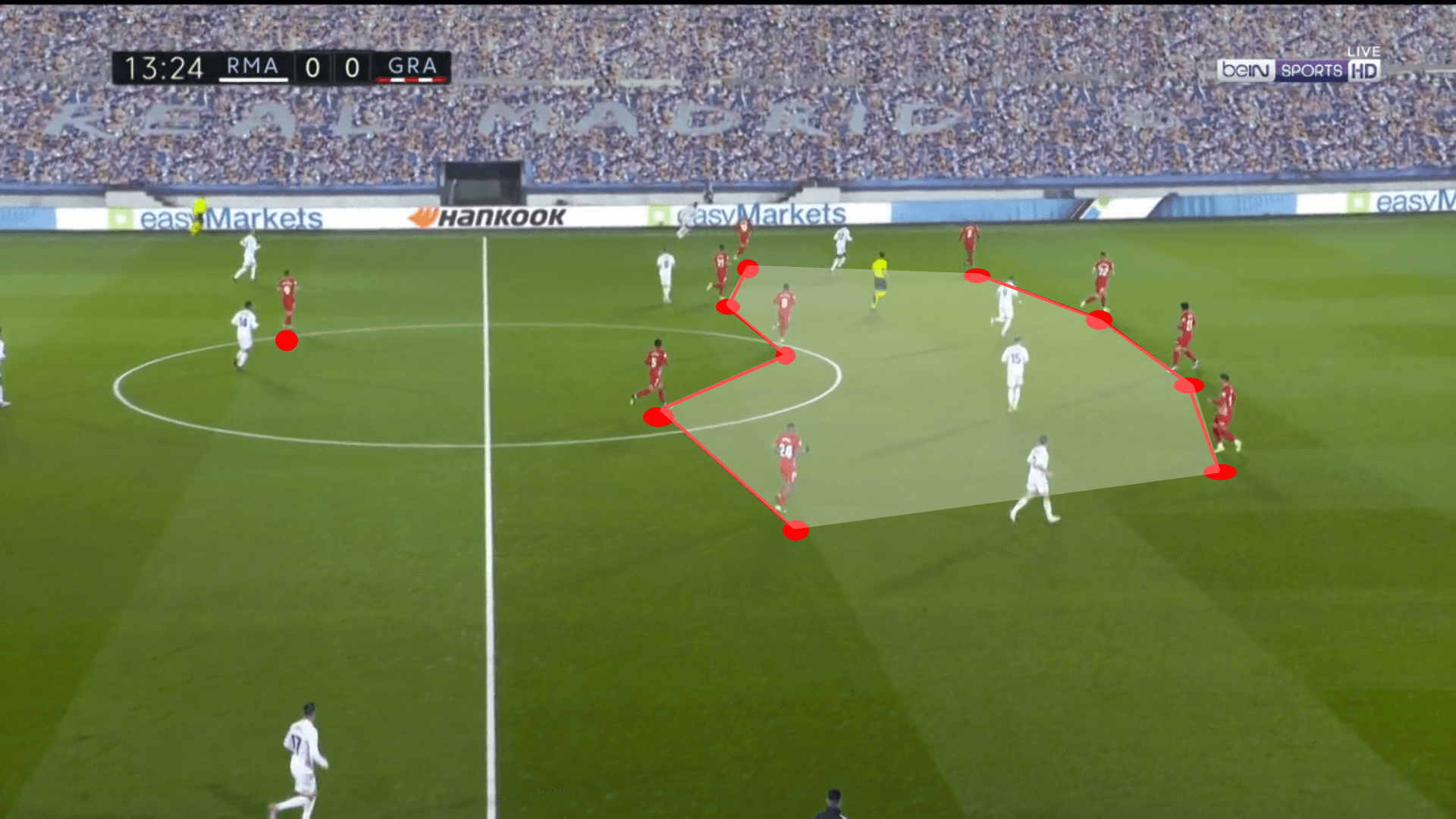
Through the field was horizontally compact, Granada did allow space between the lines. In the image above, you can see four Madrid attackers sitting between Granada’s midfield and defensive lines. The high press worked well in the first half, but the spaces between the lines, as well as lack of pressure on Ramos and Kroos, would come back to haunt Grenada in the second.
Real Madrid finds success in the build-out
With Granada willing to engage higher of the pitch, Zidane’s men looked to turn their build-ups into direct attacks. If they could break the first two lines, they were generally able to get an additional number, typically the right-sided midfielder, behind Granada’s midfield, creating a 4v4 against the backline.
In each of the attacking phases, Real Madrid took a fairly standard approach on the left-hand side, using Rodrygo and Asensio in the half spaces and Mendy has the width provider. However, on the right-hand side, the rotations and starting points managed to unsettle Grenada.
In the image below, we get a glimpse of the width providers, Mendy and Vázquez in this case, but also the asymmetric attacking structure Zidane used in this match. Vázquez offered width high up the right-wing while Mendy started a little bit lower on the left. Valverde would then push high into the right half space, very near the central channel, while Carvajal operated as an inverted outside-back, starting in line with Kroos and Casemiro.
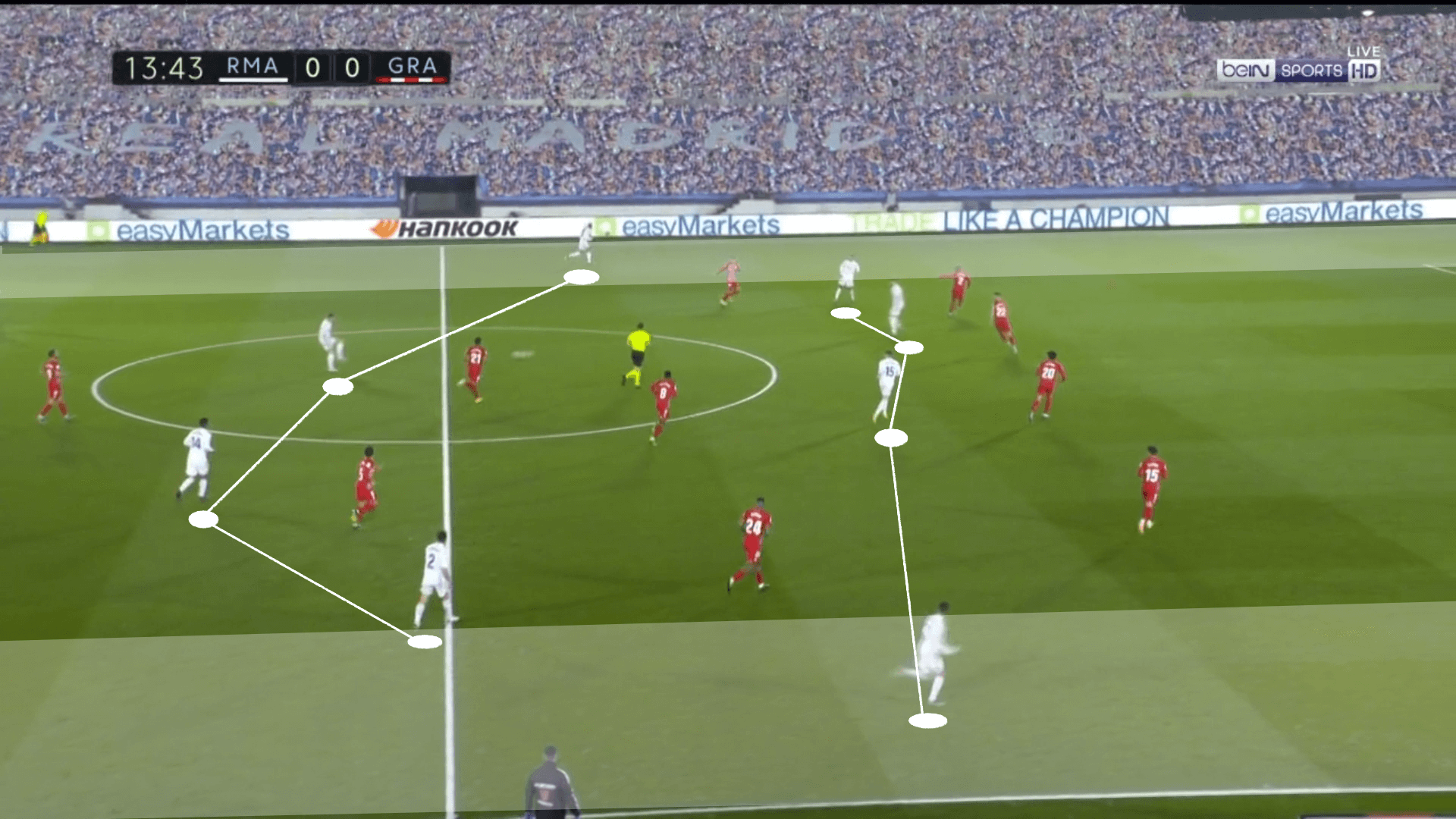
The build-out was critical to this attacking structure. In the image below, Ramos and Varane split out to the corners of the box and Kroos dropped in between them. Both outside-backs pinched into the half spaces while Casemiro and Valverde pushed higher up the pitch.
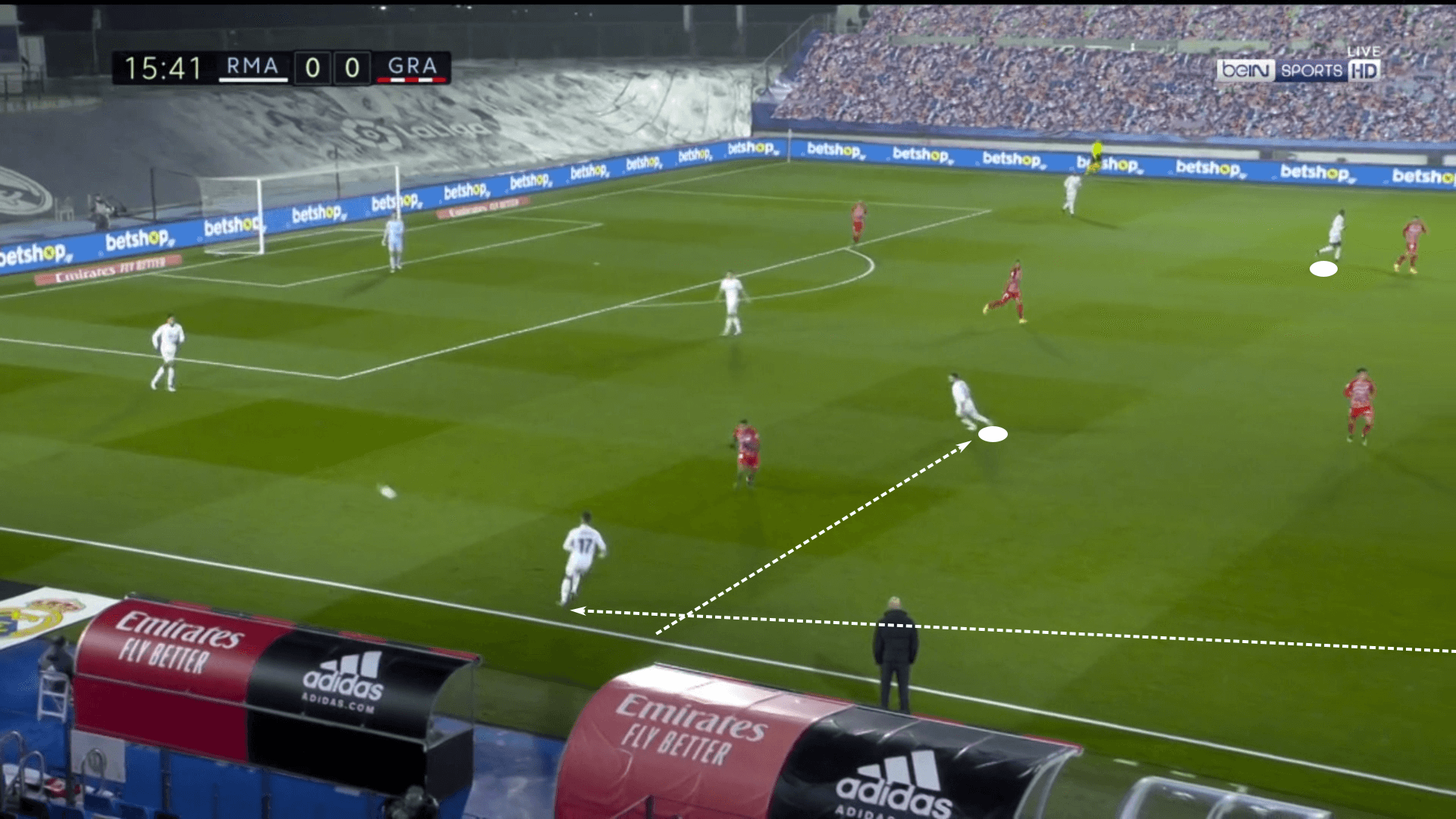
With the ball at Varane’s feet and Carvajal sliding into the half space, Vázquez moved off of his teammate, dropping deep into the wing to receive the pass from Varane. Out of the picture, Valverde has moved higher at the pitch to pin Neva back, which gives the option of the half-turn up the wing to Vázquez.
As Madrid moved into the middle third of the pitch, the deep drops to Kroos in the centrebacks allowed them to quickly switch play, attacking space in the far wing before Granada could fully slide and deny progression. Much like the build-out, the right-sided rotations were frequent and fluid as Real Madrid connected the lines.
In the sequence below, as a ball switched to Varane in the right half space, Valverde dropped deep to receive, which cued Carvajal to move higher up the right-wing. As Carvajal moved forward, Vázquez subsequently moved into the middle of the right half space. Taking his defender with him, Vázquez created space for Carvajal to advance the ball through the wing.
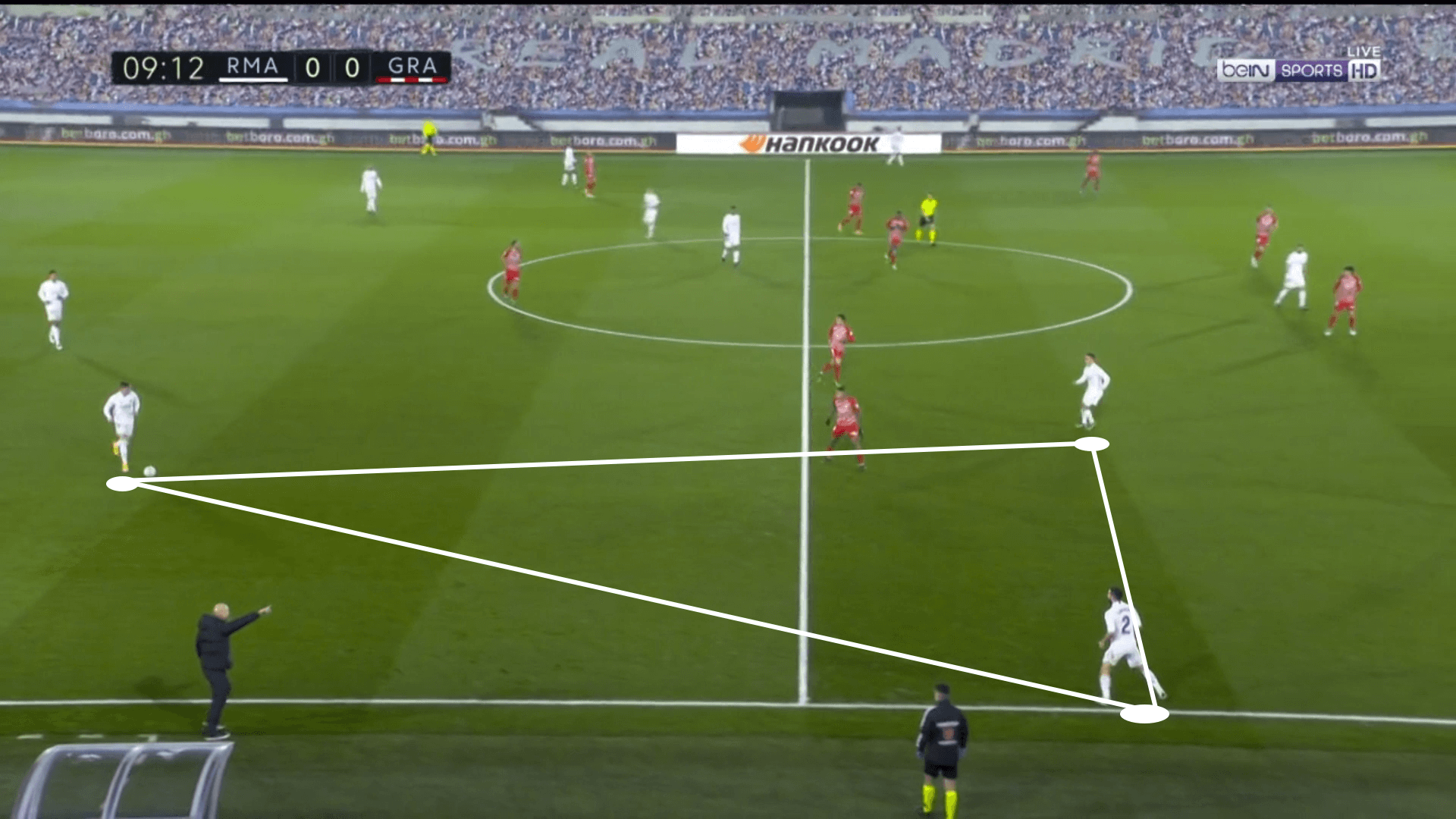
After a quick sequence of play that saw Carvajal and Vázquez combine to progress into the attacking third, the outside-back made his run inside while the forward swapped rolls with him, becoming the width provider on the right. As the two exchanged roles in the attacking third, Valverde remained deeper in coverage of Carvajal.
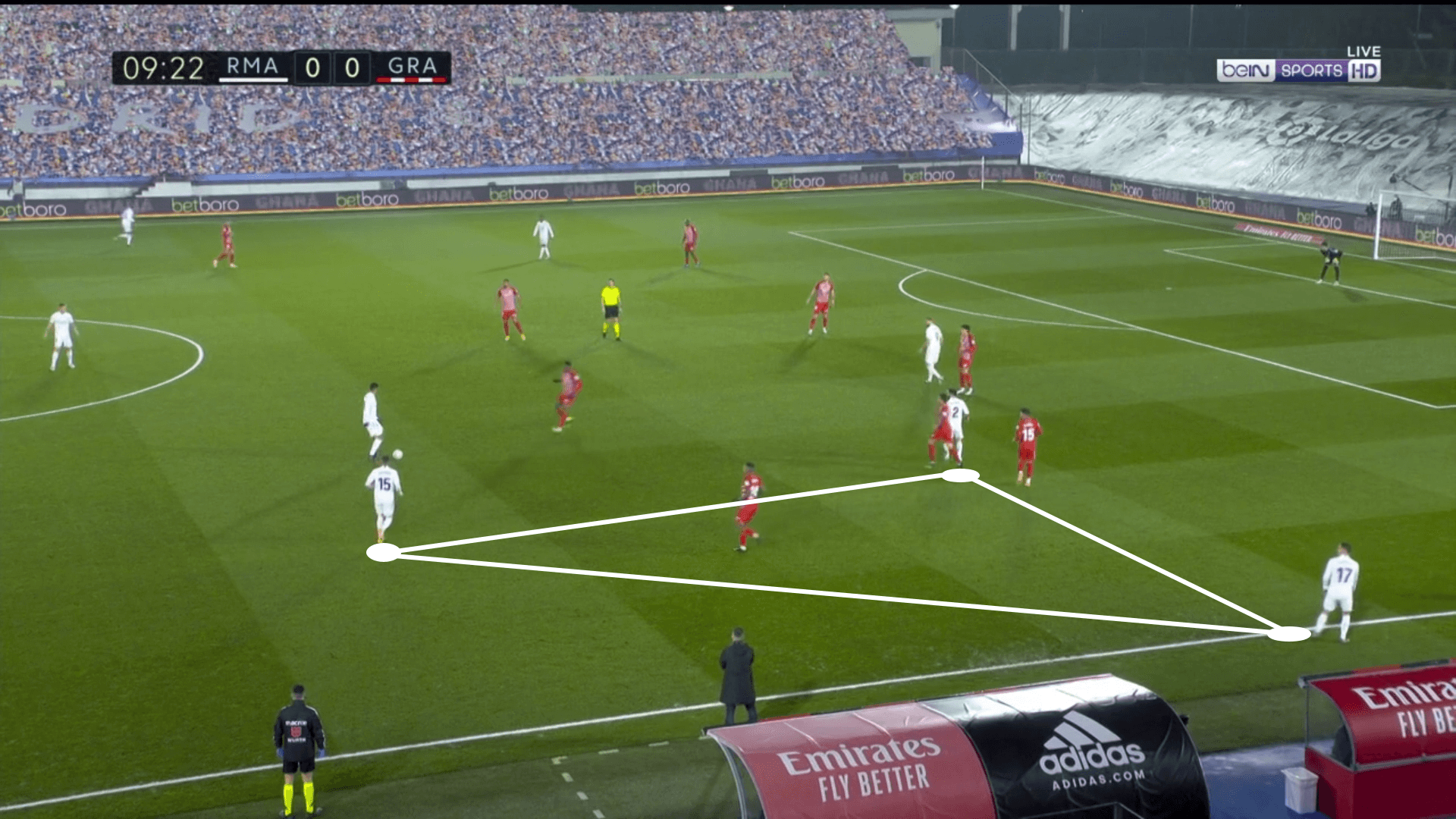
With Ramos and Kroos on the left side, Real Madrid was able to pick Granada’s lines apart with split passes. However, on the right-hand side, analysis shows that rotations were key to the team’s success. Rather than relying on one player to pass through tight angles or isolate and engage in 1v1 duels, it was the coordinated movements of the three players that led to successful outcomes. Whether it was Carvajal taking up an inverted outside-back roll, the three players moving in a counter-clockwise rotation or even Carvajal roaming the midfield in place of Valverde, Real Madrid’s right-sided rotations kept Granada off balance.
Madrid’s numbers in the box
With the score level at halftime, Madrid had produced nine shots but were short on quality chances. On the other hand, Granada’s four shots led to quality opportunities. Madrid had found a rhythm over the final 25 minutes of the first half, consistently threading the ball deep into the half spaces just outside of Granada’s box, but they were unable to finish off any moves to goal.
One of the second half adjustments was leaning on Kroos and the centrebacks to handle the majority of the build-outs. Zidane pushed Casemiro higher up the pitch, putting them in closer connection with Valverde and the forwards. The objective wasn’t to use Casemiro as a high target player or even necessarily to look for him between the lines. Rather, the goal was to get his aerial thread in the box.
Attacking third entries was another point of emphasis. Real Madrid still had their fair share of build-outs leading to direct attacks, but, if the immediate opportunity wasn’t available, they did tend to slow the play, giving Casemiro time to move higher up the pitch and time his run into the box. Between the Brazilian, Benzema and Valverde, Los Blancos could better compete in crossing situations.
The right-sided overloads were matched on the left. With Real Madrid committing numbers to the wings and half spaces, their entries into the box typically produce numeric equality at the near and far posts.
10 minutes into the second half, a right-sided attack saw the ball skip across the box all the way to Mendy on the far wing. As he picked up the ball, he, Asensio and Kroos engaged in a 3v3 with the Granada defence. With a 3v3 in the left half space and wing, as well as a 3v3 in the right house space and outer portion of the central channel, the Granada defence became stretched in the centre. Due to the lack of horizontal compaction, Kroos was able to take his touch inside and get a shot on goal.
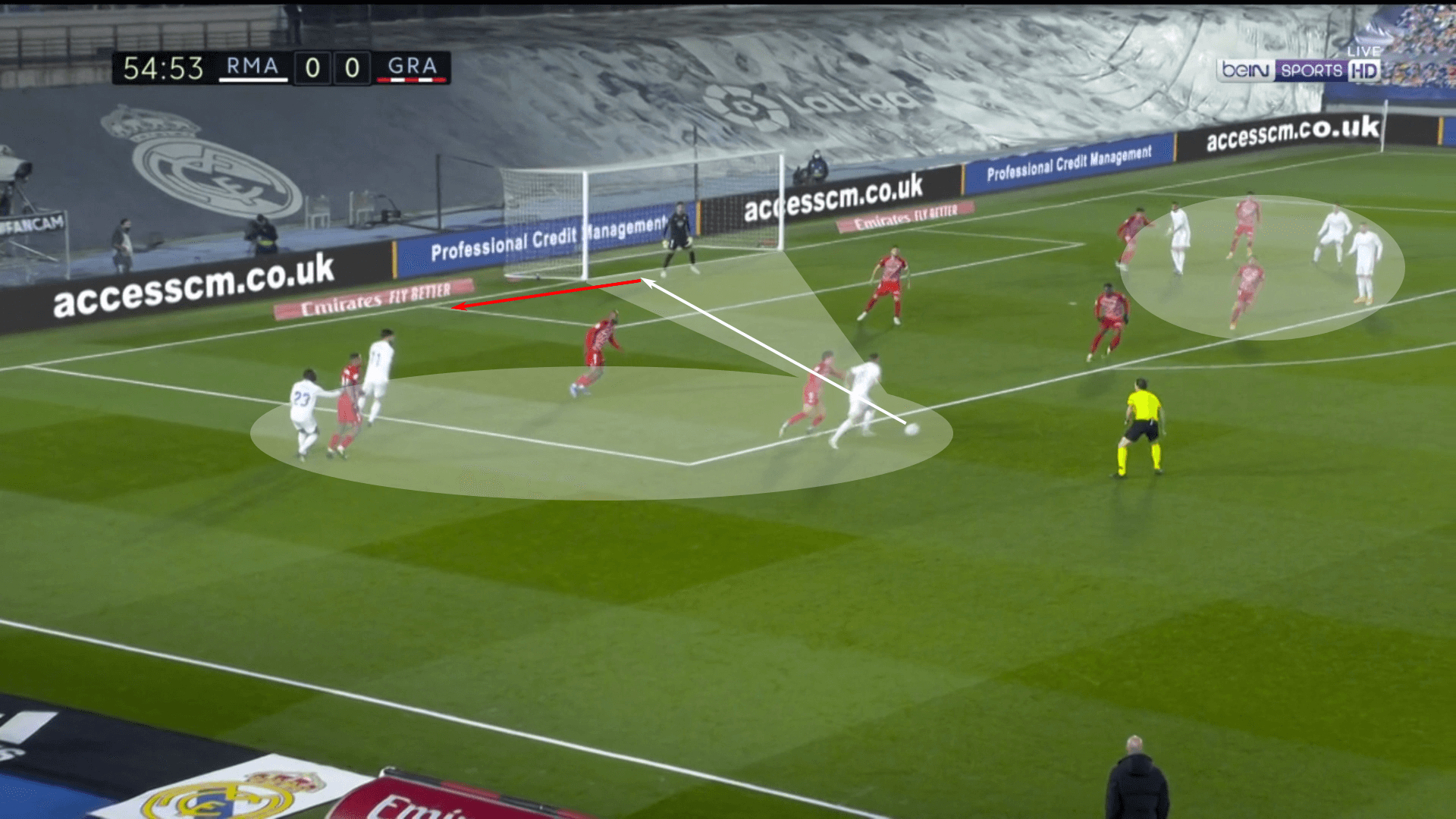
Though his run took him away from goal, it did open up a wide-open shooting lane. If you have seen Kroos hit his corner kicks, you know he can whip the ball across his body. That’s exactly what he did, forcing a difficult save from Silva which was pushed to his right, into the path of Asensio.
As Asensio prepared his delivery, Vázquez made a darting run into the goalmouth while Valverde and Benzema held their ground at a deeper starting point. Asensio’s pass was right on the money, arriving at Valverde’s feet. The Uruguayan got his shot on target, but Silva recovered his ground well, pushing the ball to his left. Benzema managed to get a shot off, but his effort was off target. No goal, but the cracks in the defence were becoming evident.
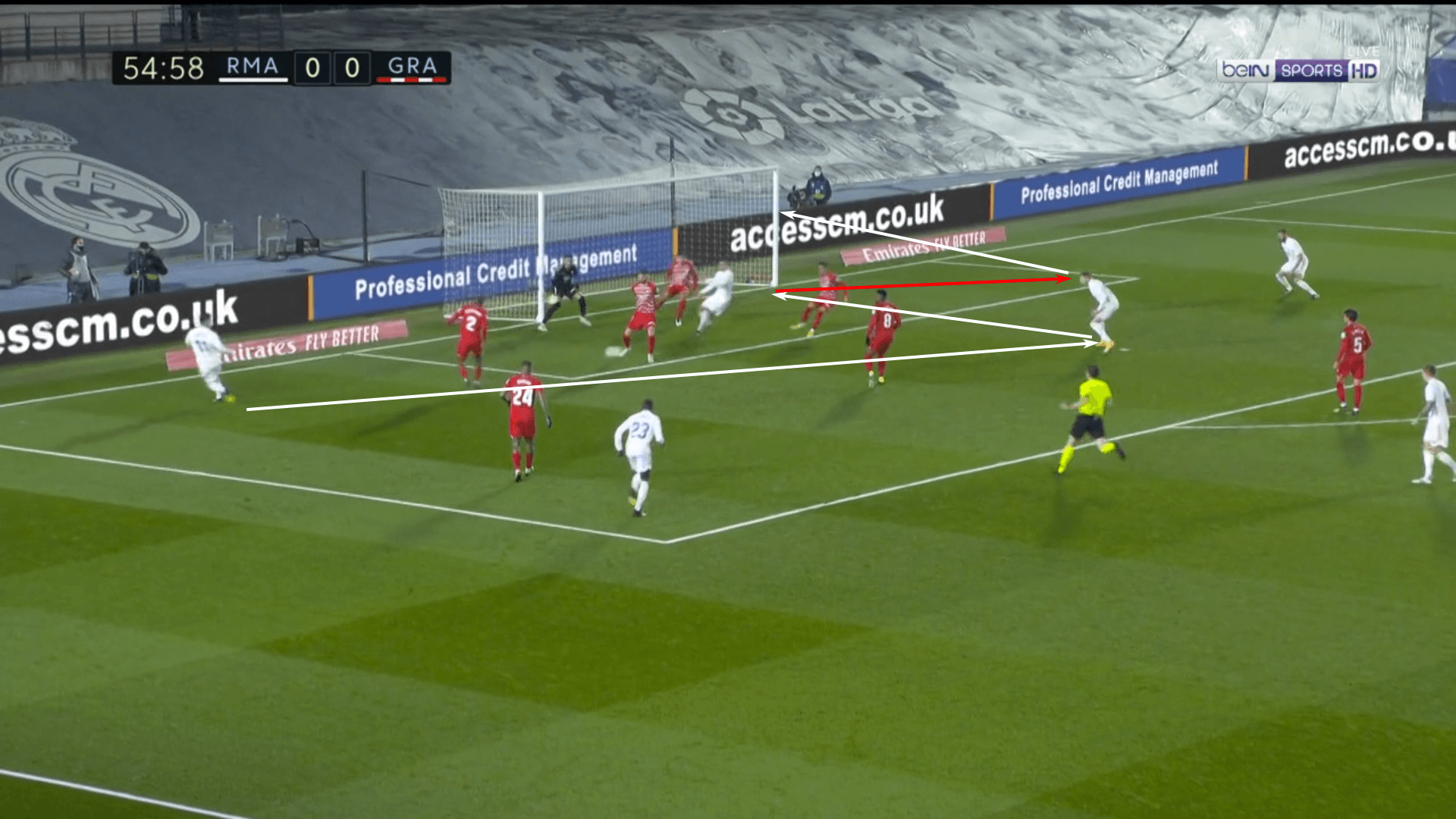
Fewer than 90 seconds after that sequence, Los Blancos found their breakthrough. Again, the starting point was the right-sided overload. With a ball played negatively to Ramos, then left to Kroos, Madrid found themselves in a spot where Mendy was the lone presence in the left-wing. Kroos sent his second touch to the Frenchman. Notice the positioning of Casemiro, the advanced midfielder with the white circle beneath him.
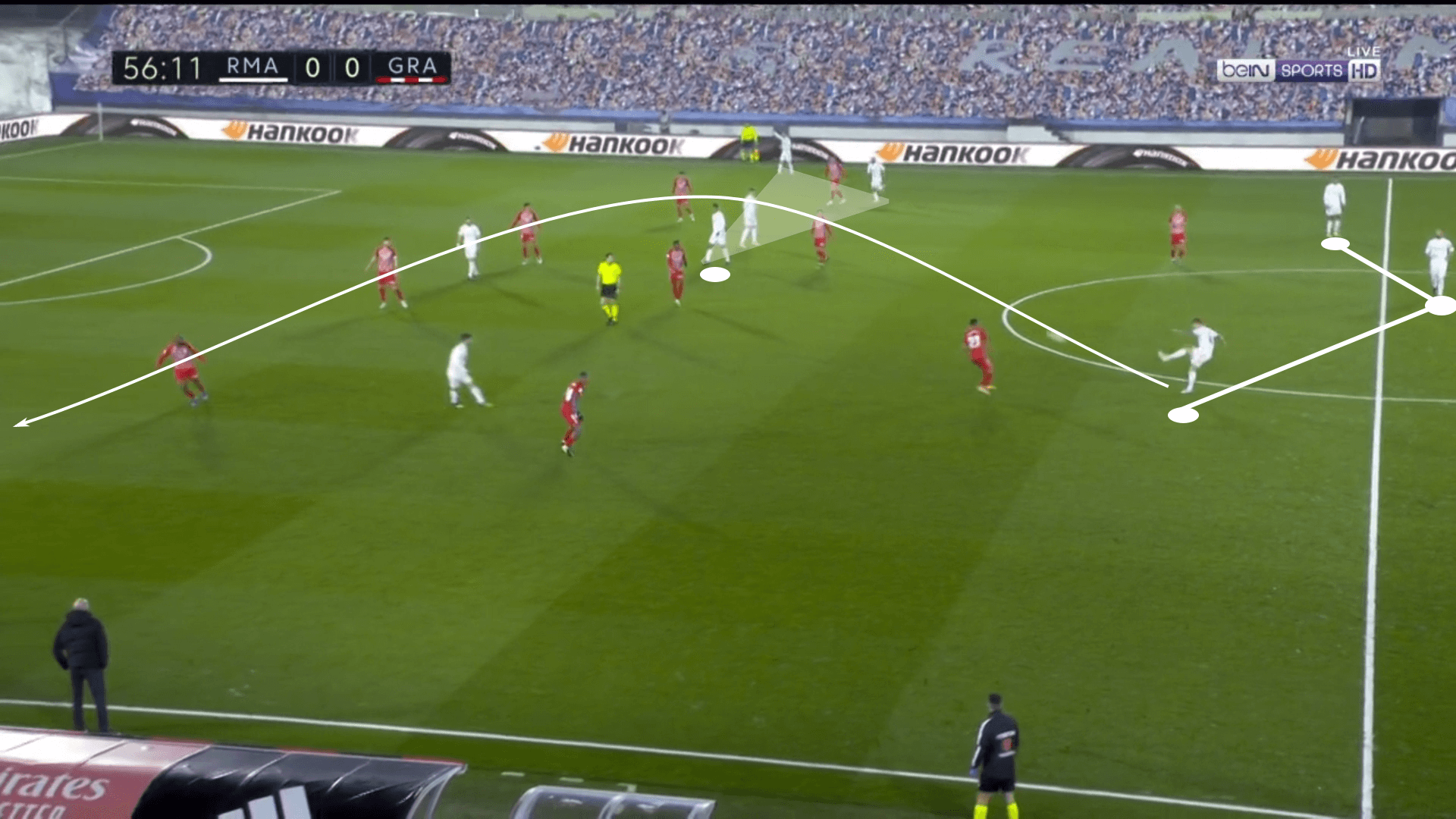
Foulquier left the half space to pressure Mendy. In doing so, a massive gap emerged between him and Duarte. Asensio saw the gap in burst through it, leaving Puertas to chase him.
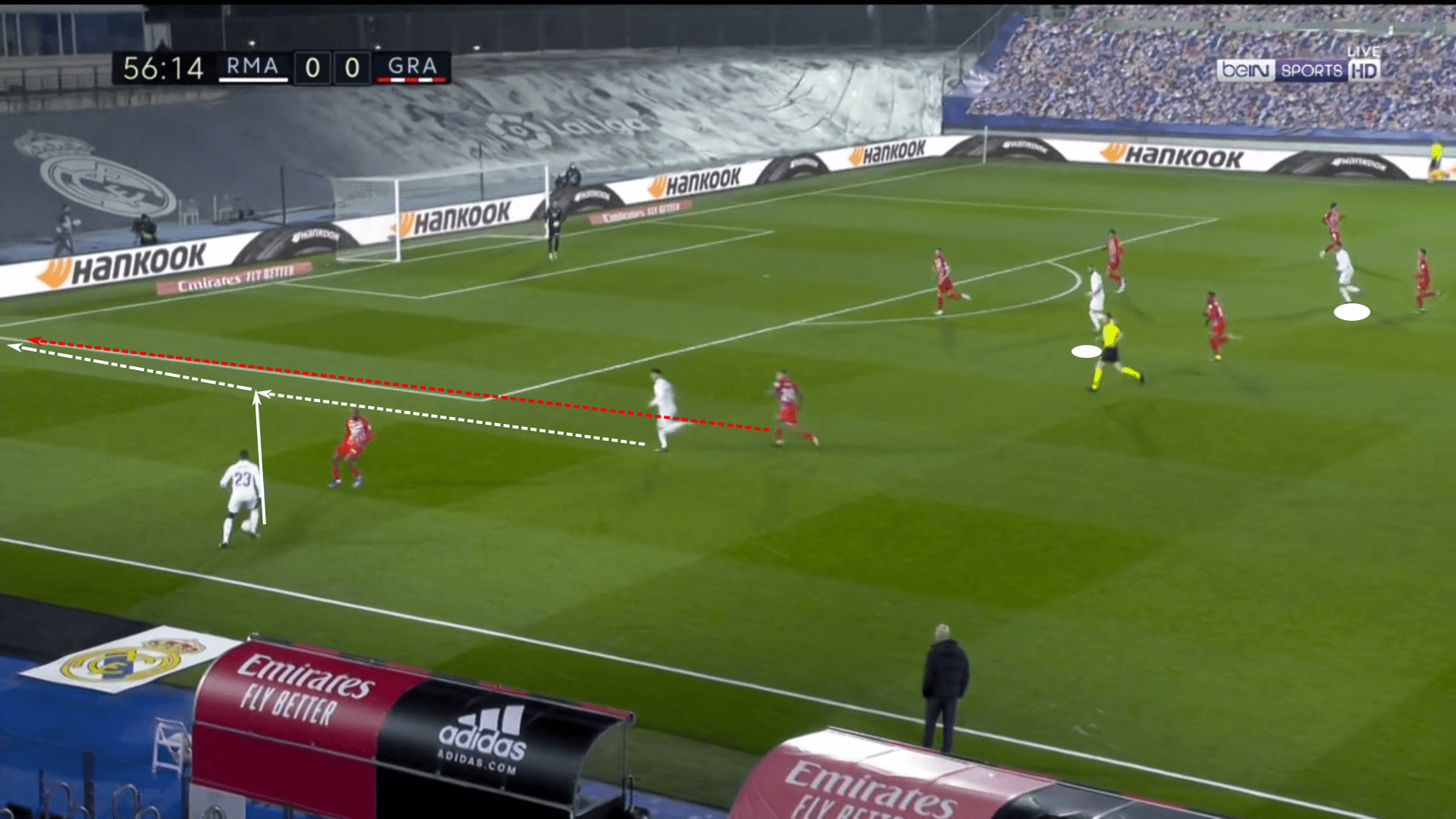
Asensio managed to buy his teammates a couple of extra seconds and create a crossing lane with a little shoulder faint. As he delivered the ball into the box, Benzema made his run into the goalmouth while Casemiro made a late run to the back post. The lofted ball was beyond the reach of Silva and just behind Vallejo. Casemiro timed his run to perfection, easily out-jumping Vallejo and smashing home the game-winner.
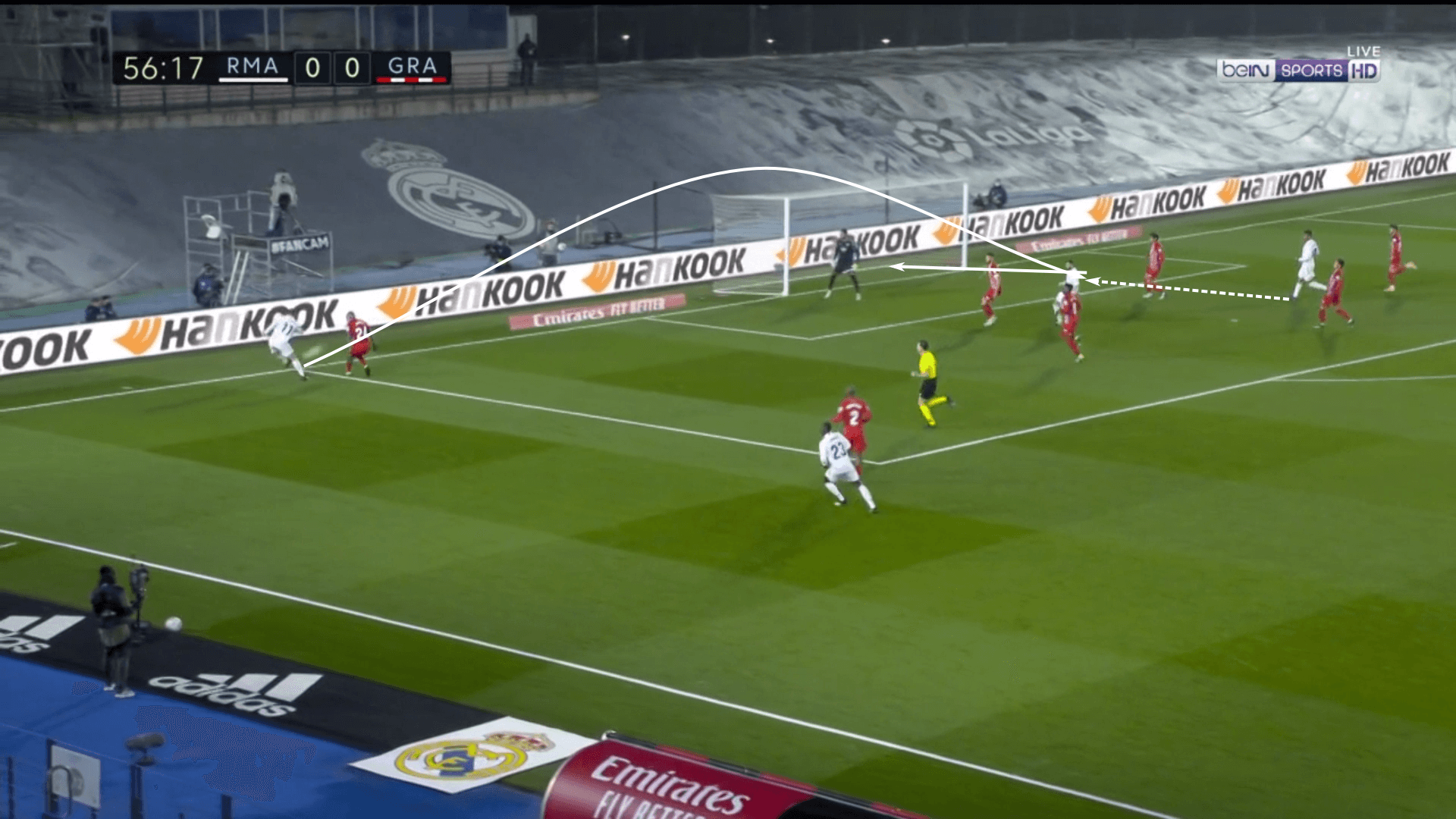
Whereas the first half featured a number of nice build-outs leading to direct attacks on goal, Madrid didn’t consistently have numbers in the box to meet the final pass. Zidane adapted in the second half, ensuring his side had adequate numbers in the box. Asensio’s deliveries were lethal in this game, rewarding Zidane for his selection over Eden Hazard and Vinícius Júnior.
Further, pushing Casemiro higher up the pitch provided the winner. With just Soldado remaining high of the pitch, Real Madrid used Kroos to protect against counterattacks in the left half space and one player from the right-sided trio to protect the right half space. Their rotations and zonal discipline, as well as their counterpressing, safeguarded their side of the pitch.
Conclusion
The win keeps Real Madrid level on points with Atlético Madrid. Keep in mind that the crosstown rivals have two games in hand, so Los Rojiblancos have a cushion.
Even though Atlético’s in the driver’s seat, it must be said that Real Madrid is playing their best football of the season. They now have six consecutive wins, outscoring their opponents by a margin of 13 to 2 over that stretch with a match against a sputtering Elche side next.
Granada remain in 7th place, dropping just their second game of the month. Like Madrid, they seem to have put a difficult early slump behind them. Though they didn’t have many chances in this game, they did have a few that were especially promising. Martinez will be disappointed with the 20 shots allowed and the relative ease with which Los Merengues beat the press, but his side will look to right the ship on Wednesday against Valencia.





Comments